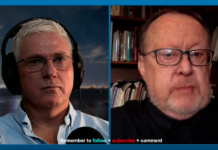Analysis by Keith Rankin.

Peter Turchin, author of End Times, has spent many years researching cliodynamics. His works in the 2000s include Secular Cycles (2009) and War and Peace and War (2007). A central concept in communicating his research is that of asabiyya, a word gifted to us from the renowned North African philosopher and polymath Ibn Khaldun (1332-1406).
Asabiyya very loosely translates as ‘social capital’, especially in the context of Robert Putnam’s seminal book Bowling Alone (2000). More completely, asabiyya is a concept of collective cohesiveness, which can be used to explain why some national (and often sectarian) groups prevail against the odds in inter-‘national’ conflicts. Turchin’s research context is that of the agrarian empires whose rises and falls represent much of the drama of pre-industrial history; though it is a concept that can be carried over into modern times. Turchin, as a Russian-born American, is able to infuse his writing with many of the great historical dramas which are little-known to anglo-biased readers.
Asabiyya should never be confused with virtue. It represents a kind of collective spirit through which individuals are willing to die for a collective cause. Turchin’s hypothesis is that geopolitical success requires unusually high levels of asabiyya, at least in the earlier stages of empire-building. And he finds that, at least in pre-industrial history, asabiyya is generated on the frontiers; on the meta-ethnicfrontiers where very different cultures meet and collide. Additionally, long-running historical empires display consistent centuries-long patterns of rising and falling asabiyya; patterns which Turchin calls ‘secular cycles’.
On meta-ethnic frontiers, the cultural divide is as much – maybe more – linked to culture (especially religion) than to ethnicity or race. Asabiyya typically develops on both sides of such a frontier, and will be displayed by both attackers and defenders in escalating frontier conflicts. When an offensive (as opposed to defensive; but often also ‘offensive’ in the sense of being brutal) collective prevails, it moves into the non-frontier regions (with lower asabiyya; with more internal division and more inequality) of its meta-ethic adversary. Military life becomes easier for the attacking force, unless those internal divisions in the defending ‘nation’ can be resolved quickly.
The best-known exemplar, at least to western readers, is the rise and fall (and rise and fall, and rise and fall) of the Roman empire (using ’empire’ in a more general sense of regional hegemony rather than the more formal political concept of ‘Empire’). Indeed the disconcerting divisive cracks opening up in our western empire today seem to be leading to a renewed interest in the dynamics of the Roman Empire. Other examples of asabiyya familiar to English-speaking military history buffs will be the Scottish rebuffing of England in the 14th century (think Robert Bruce at Bannockburn), and the English military success in France in the first two-thirds of the Hundred Years War (think the Battle of Agincourt in 1415).
In more recent times, epic struggles include the Napoleonic Wars, the United States Civil War, and the wars of German expansion of the twentieth century. These struggles were epic precisely because both sides had high levels of asabiyya, although asabiyya fluctuations on each side contributed to the many reversals of fortune. Overall, at least in the latter two conflicts, the losers (the Confederacy, and the German military) lost despite having (for the most part of each struggle) higher asabiyya. For the victors of these struggles, asabiyya was lower, but high enough.
The biggest eroders of ‘national’ (using the term loosely, and generally) asabiyya are internal division; especially elitism (and the inequality it provokes) and cultural division. An excellent 1970s’ book which raised these issues of corroding social capital – a book ahead of its time – was The Social Limits to Growth (1976) by Fred Hirsch.
Asabiyya is a concept which can help us to make predictions about the future of the world in (and beyond) the second quarter of the twenty-first century. Too many of the predictions we make (and make policy on) are simple extrapolations; projections which cannot incorporate ‘out-of-left-field’ events, black swans or even grey rhinos. Yet we all know that the next 25 years will include a multiplicity of these.
In War and Peace and War, Peter Turchin notes the low levels of Asabiyya in Palestine in the wake of the dissolution of the Ottoman Empire (after WW1). And we note the much higher levels of asabiyya amongst the Jewish settlers in Palestine from the 1920s; the eventual result being a revolutionary war of terror; a foundational war which brought about the end of the British Mandate and the creation of the nation state of Israel.
We also note now that asabiyya has declined substantially in the west, and is declining in Israel too. And, as Turchin noted even in 2007, asabiyya has become much more potent in Palestine than it was from the 1920s to 1940s. Indeed we see that Palestinians in the West Bank and especially Gaza are facing an existential crisis from the offensive behaviour of their occupying meta-ethnic foe; and that they are not shrinking from it. Palestinians are documenting their own existential struggle – not clamouring at the Philadelphi Corridor to leave as refugees – and will do so to the last man or woman, or until they prevail. I wouldn’t bet against them.
(We may note that the victims of genocide in Rwanda in 1994 prevailed with minimal outside help – except from Rwandan expatriates – and have created one of the most modern nation states in Africa. Asabiyya must surely be a factor in this remarkable but underappreciated outcome.)
Secular Cycles
On the matter of secular cycles, these long cycles work as follows in Peter Turchin’s model. Expansion and/or economic development take place when inequality and division is low, when a nation or sovereign territory has low inequality and a sense of common purpose (thanks in part to a diminished elite); that is when asabiyya is high. The second stage of each cycle is characterised by the creation and expansion of new elites, in the wake of a resurgence of more familiar elites; the struggle between elites and non-elites. The third and final stage is the contraction of elite-space, the struggle for supremacy in a context of economic decline; in this stage of the cycle, non-elites quietly rebuild.
In a ‘typical empire’, the cycle can be expected to repeat perhaps twice; asabiyya reestablishes with the absolute fall of some of the elites and the relative fall of those elites which survive, and a new consolidation and growth phase takes place. During the final set of phases, asabiyya builds up outside the empire which has prevailed for centuries.
We can clearly see that asabiyya was high in the post-war western world, for a mixture of reasons; especially: the need for construction of institutions and infrastructure, the acceptance of decolonisation, and the rivalry of the Cold War (including the ‘space race’). Asabiyya took a substantial hit from the 1960s but especially in the 1980s, with the Vietnam War, the neoliberal coup, the untimely reawakening of the Cold War from the late 1970s, the dissolution of the ‘Communist’ enemy (the so-called ‘end of history’) around 1990, and the primacy of global finance.
One interpretation is that the modern world, at least since the 17th century, has been characterised by an Anglo/American empire. (Before that was a ‘Mediterranean empire’, which had three cycles with different overlapping loci: a Byzantine period, an Islamic period, and a Catholic period culminating in the Spanish and Portuguese global empires.) The first dissolution stage of the Anglo/American empire took place in the years from 1776 to 1848; an ‘age of revolutions’. The second dissolution stage took place in the 1930s and 1940s. The third cycle is proving shorter; the expansionary phase from 1948 until 1974, the elitification phase from 1975 (but not until 1985 in Aotearoa New Zealand, with Rob Muldoon holding back the tide) and what could be the beginnings of a dissolution phase – possibly a final dissolution phase (a black swansong, if you will) – from the 2020s.
*******
Keith Rankin (keith at rankin dot nz), trained as an economic historian, is a retired lecturer in Economics and Statistics. He lives in Auckland, New Zealand.








